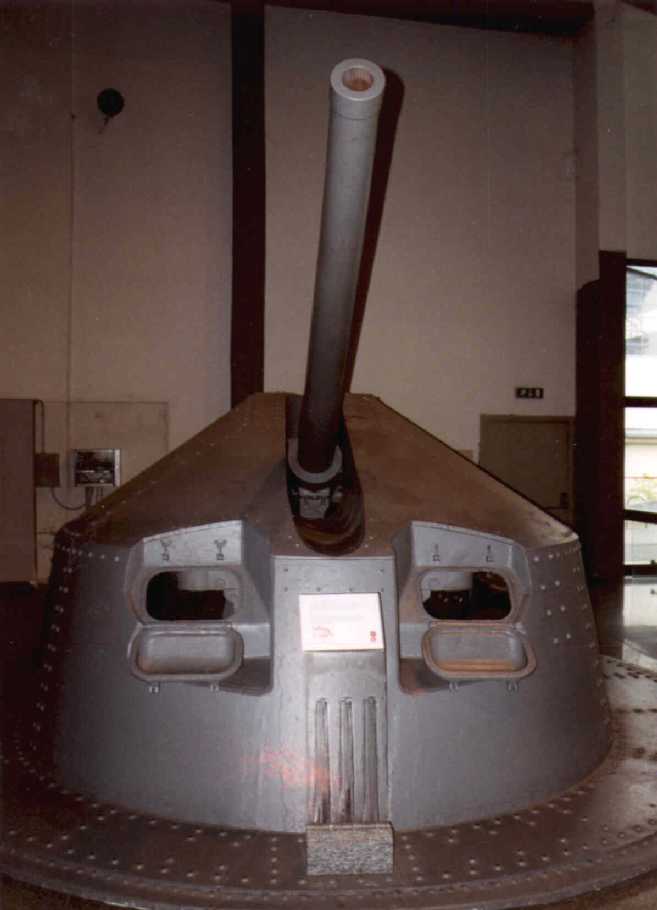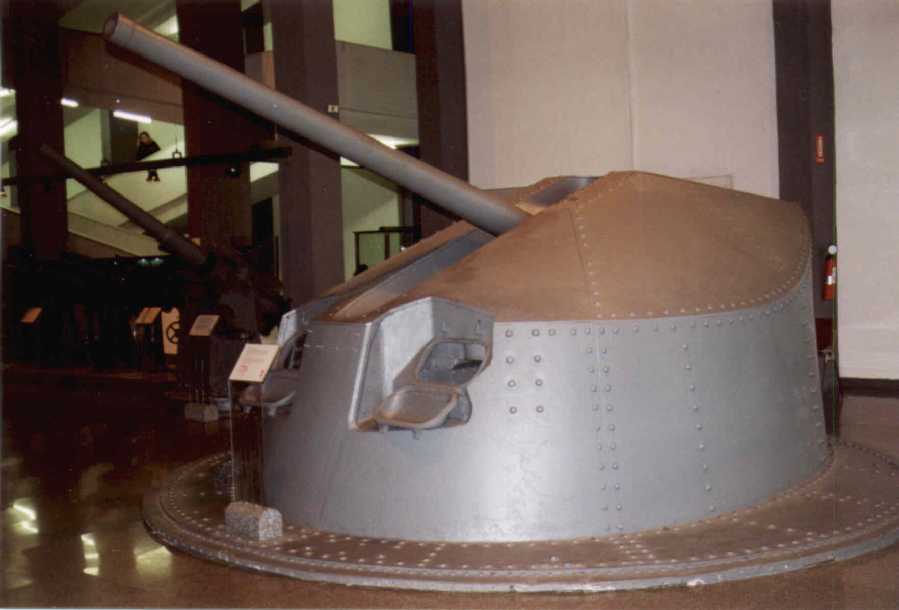

Developed by Ansaldo, these two models were similar in design. The guns had good ballistic properties for their caliber, but their stabilized mountings were too advanced for their time and experienced many technical faults. The mountings were stabilized in four axes; training, elevation, roll correction and pitch correction. Eleven gyros were used in a very complex arrangement to maintain stabilization. RPC was fitted but removed from the Duilo class in 1942, apparently because of water damage. The Littorio class had their mountings located much higher and retained RPC. However, even these ships suffered from frequent electrical and mechanical breakdowns.
In 1938 plans were made to rebuild the Alberico da Barbiano (1st Condottieri) class into AA cruisers. These plans entailed removing all existing armament and rearming the ships with sixteen 90 mm/50 guns in single mountings, arranged six forward, four amidships and four aft along with ten twin 20mm MG mountings. This plan was not implemented due to financial considerations and the need to prioritize gun production for the battleships.
Constructed of autofretted monobloc barrel with a screwed-on breech ring holding the horizontal sliding breech block and seatings for the run-out and recoil cylinders. The gun barrel was attached to the receiver by a bayonet joint. The original design was 48 calibers in length, but the production guns were 50 calibers long.
There was also a 90 mm/53 gun for land use produced during the war that was considered to be one of the best Italian AA weapons. This weapon continued in service until the 1950s.
| Designation | 90 mm/50 (3.5") Model 1939 |
|---|---|
| Ship Class Used On | Doria and Littorio classes Prototypes tried on San Giorgio |
| Manufacturer | Ansaldo and OTO |
| Date of Design | 1938 |
| Date In Service | 1940 |
| Gun Weight | 1.8 tons (1,960 kg) |
| Gun Length oa | N/A |
| Bore Length | 177.2 in (4.500 m) |
| Rifling Length | N/A |
| Grooves | N/A |
| Lands | N/A |
| Twist | N/A |
| Chamber Volume | N/A |
| Rate Of Fire | 12 rounds per minute 1 |
- ^Well trained guncrews could reach 16 rounds per minute, but 12 rounds per minute was the normal rate.
| Type | Fixed |
|---|---|
| Weight of Complete Round | 40.6 lbs. (18.4 kg) |
| Projectile Types and Weights 1a | HE AA 2a: 22.5 lbs. (10.1 kg) |
| Bursting Charge | N/A |
| Projectile Length | N/A |
| Propellant Charge | 7.5 lbs. (3.4 kg) |
| Muzzle Velocity | 2,822 fps (860 mps) |
| Working Pressure | 19.37 tons/in2 (3,050 kg/cm2) |
| Approximate Barrel Life | N/A |
| Ammunition stowage per gun | Littorio: 487 rounds 3a Others: N/A |
- ^Illumination rounds were supplied but these were considered to be inadequate due to their small size.
- ^AA rounds were considered to have good ballistic behavior and accuracy, but early rounds fragmented into very small pieces, limiting the effective bursting range. Rounds with better fragmentation patterns were introduced during the war and these remained in service with the land-based guns into the 1950s.
- ^Outfit for the Littorio class was 5,842 AA and 50 illumination rounds. Handling rooms held 90 ready rounds.
| Elevation | Distance |
|---|---|
| 45 degrees | 14,220 yards (13,000 m) |
| AA Ceiling | about 35,400 feet (10,800 m) |
| Designation 1b 2b | Single Mounts 3b: Doria (10) and Littorio (12) |
|---|---|
| Weight | 18.77 tons (19.07 mt) 4b |
| Elevation | -3 / +75 degrees |
| Elevation Rate | Manual operation, only |
| Train | about +120 / -120 degrees |
| Train Rate | Manual operation, only |
| Gun recoil | 19 in (48.4 cm) |
- ^Two prototype mountings with 48 caliber guns were tested on the armored cruiser San Giorgio in 1938.
- ^Two unstabilized mountings were planned for arming the fast sloop Diana but these were canceled and she received two old 102 mm/35 (4") guns in their place.
- ^Gunhouses were oval in shape and sharply raked so as to minimize overpressure effects from the main guns.
- ^
Armor thickness for the Littorio Class given in "The Littorio Class: Italy's Last and Largest Battleships 1937 - 1948" Face 1.6 in (4.0 cm) Sides 1.6 in (4.0 cm) Rear 0.5 in (1.2 cm) Roof 1.6 in (4.0 cm) - Fixed rounds were supplied from the magazine to the main deck by an electric hoist capable of supplying 30 rounds per minute. Rounds were passed by hand up to a handling room forming the lower compartment of the mounting. From here, a short hoist attached to the stabilized structure raised the rounds vertically to the gunhouse and then rotated them horizontally. The hoist was driven by a 2hp electric motor and could be operated at 12, 16 or 30 rounds per minute. An automatic fuze setter was part of the top of the hoist. Rounds were loaded by hand with a pantograph link rammer (a mechanical linkage in the style of parallelograms)
- Roll correction was +/- 14 degrees and pitch correction was +/- 5 degrees.
"The Littorio Class: Italy's Last and Largest Battleships 1937 - 1948" by Erminio Bagnasco and Augusto de Toro
"Naval Weapons of World War Two" by John Campbell
"Italian Warships of World War II" by Aldo Fraccaroli
"Anatomy of the Ship: The Cruiser Batolomeo Colleoni" by Francis Gay and Valerio Gay
07 October 2006 - Benchmark
26 May 2012 - Updated to latest template
21 September 2012 - Added mounting information
12 January 2013 - Added notes about rate of fire, ammunition outfit and land based version
28 January 2014 - Added information about planned rebuild of the Alberico da Barbiano class
10 January 2015 - Added armor thickness
20 May 2020 - Converted to HTML 5 format, reorganized notes
15 August 2023 - Corrected formatting problem
